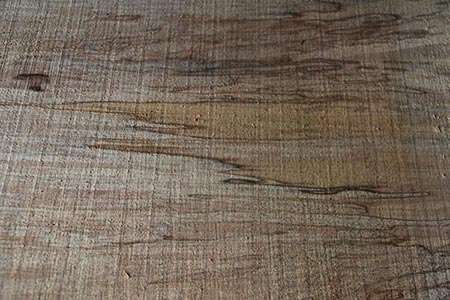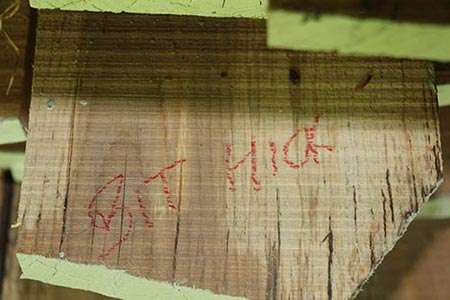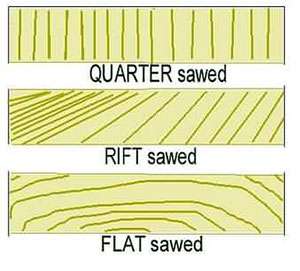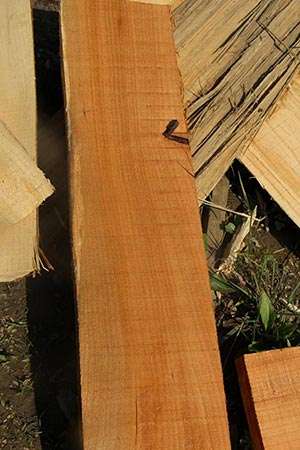I’ve been trying to line things up to build a house for a few years now, and am getting nowhere fast. I’ve made some recent progress milling hardwood, though, that I’ll someday turn into flooring, and molding, and whatever else. There are 16 species of board-worthy hardwood trees growing on the back 40 – that’s a shoot-from-the-hip number that doesn’t count shrubby trees (other than hophornbeam) and doesn’t count species like white oak and shagbark hickory that I wouldn’t be cutting anyway because they’re rare on this particular piece of land.
I’ve been scrounging most of the wood, which gives things a treasure-hunt feel. So far my biggest coup has been some black birch that sat on the bottom of a pile of log-length firewood for three years and took on some really nice staining – blues and greens that I hope will really pop amidst the warm reds and browns the wood has naturally when the board is finished. Birch is my favorite wood, and when the project started I was sure that the living room floor would be birch. As I get going, though, I’m becoming smitten with pretty much every species I cut. I don’t really like flat-sawn red oak, but quarter saw it so you get those ray flecks and it’s striking. I was similarly struck by the wood in some bitternut hickory logs we had lying around. It seemed a little boring at first (and hard – phew, the small, basic sawmill I’m cutting on liked this species the least), but as the wood started to cure it took on a pink patina that’s really quite lovely.
We had a beaver dam up a small creek in a riparian strip between two meadows and live there for about a year; unfortunately for the beaver the dam was blocking a culvert that runs under a railroad track. We wanted the beaver and the pond but the railroad company didn’t – you can guess who won that argument. Anyway, I’ve been down in that floodplain cutting standing dead trees that were killed by the high water. I’ve been able to extract a bunch of little black cherry logs – the butts will be turned into boards, the tops sap wood. There was also a maybe 14-inch elm that I got a good butt log out of, which I’m excited about.
The milling I’ve done in the past – mostly just live-sawing pine – has been relatively crude. You throw a log on the mill, you blow through and turn it into a bunch of one-inch boards as fast as you can. This project has forced me to slow down and attempt to saw for grade, as the real sawyers say. It’s made me really appreciate the art. I’ve progressed from making boneheaded beginners’ mistakes (putting the log on tapered end first and having your first slab start at a half-inch in diameter and end 8 inches in diameter; seeing a rock on the bark you forgot to remove as you’re milling, and backing the mill up slightly as it’s running, promptly turning the blade into a pretzel) to making boneheaded intermediate mistakes that waste wood and lower yield. As with most crafts, the more you learn, the more you wonder what else you’re missing.
If you’ll forgive a self-serving turn in the narrative, I have some questions. If there are any experienced sawyers reading this, maybe they can offer insight, or point me in a good direction.
1. A lot of my wood is coming out somewhere between quarter sawn (I’m defining that to mean if you look at the end grain the lines are pretty much straight up and down) and flat sawn (end grain has a frowny or smiley face pattern). If you look at the diagram below a lot of my wood looks like what’s called “rift sawed,” though that image is just something I pulled off the Web and I’m not sure they’re using the definition correctly. I’m interested in the nomenclature, but more so in the practical application. Is that “rift sawed” lumber going to be more stable than flat sawn? Or am I wasting my time trying to make mostly quarter sawn boards that don’t end up being perfectly quarter sawn?
2. Along these same lines, a lot of the trees I’m cutting are less than perfect in form – especially the cherry, which can’t seem to figure out which way is up as it grows. I’m discarding logs that are twisted, but I’ve been milling bowed logs. (See picture of wavy grain pattern in slab.) Should I be worried about this wood warping?
3. When I go to turn this into mixed-width flooring, do I have to worry about putting a groove on the back of the board like you find in commercial hardwood flooring?
4. Can I do a tongue-and-groove mixed species floor – say, cherry, black birch, and hard maple? Or is that just asking for trouble? If you have an opinion one way or the other, say why with real world examples.
5. If I air dry the lumber down to 15 percent moisture content, can I use an attic and a fan instead of paying for kiln drying to try to get it down to 6 percent?
Thanks for any insight you have. I’m very lucky to have so much collective wisdom on the other side of the computer screen.







Discussion *